Adjusting the hammers
Why does Chime Hammer Positioning Need to Occur
Mechanical clock chime hammer positioning is easy to do. It only involves bending the hammer head wires. Upon the initial installation, this was done by the clock maker as well.
When replacing a clock movement you need to bend the chime hammers to the chime rods. This is why the hammer heads are on bendable wires.
They are meant to be bent into the perfect position. It is not uncommon to bend them an inch this way or that way. The clock movement will not have the hammers in the perfect spot to make the correct sound when hitting the rods. This is why chime hammer positioning is so important.
Clock Chime Hammer Positioning
A mechanical clock movement has hammers that need to be bent into their final position. The correct clock-chime hammer position needs the tops of the hammer heads to be about 1/4 inch down from the chime block.
The hammers need to be 1/8 inch away from the rod. This would be when it is at rest. In other words, bend the hammer wires so the head is 1/8 away from the chime rod. This spacing between the head and the rod is so it will not thud or double strike.
Tuning the mechanical clock chime
Repeat this process for each wire, one hammer at a time, down the line. Continue in this manner until you can lift and drop the hammer to create a crisp sound. If each hammer head is done this way the clock will have a nice song in the end.
Often a customer will say the sound is not correct. This is due to improper hammer positioning. When performing the above directions correctly the sound is beautiful.
Positioning the 340 / 341 series
The 340 and 341 Hermle clock movement series went through a change in the hammer wires. The hammer heads were on wires, but now they are made on flat bars. The positioning is still the same, however it is a little more difficult to bend them.
The hammer head is on the skinny end of the bar. The bar gets wider as it goes back toward the roll pin.
With needle nose pliers, bend this bar where it goes from skinny to wide. The overall assembly will be slightly higher from the chime block. That is, if you are swapping out the movement with the older style wire hammer head rod.
It is an option to raise the entire chimeblock with a shim to help with this. It is not an absolute requirement. Bending the hammer arms are usually sufficient.
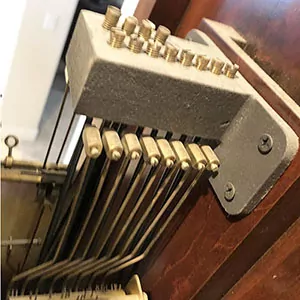
For a clean crisp chime sound
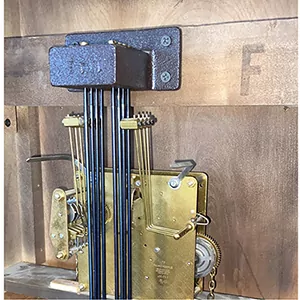
Adjust the hammer wires
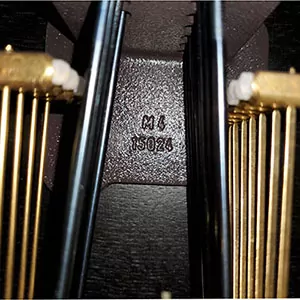
Should be about 1/8 away at rest
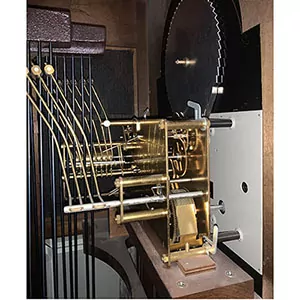
Sometimes they are bent to the extreme
Setting the strike
Mechanical Clock Strike Setting
Mechanical clock strike setting is not hard. Some simple fixes can correct any problems. This information is for a new unit straight out of the box. Subsequently, for installation into an existing clock case. However it is also practical for other situations where there are strike issues German clocks. The strike issues can be from not striking at all to not striking the correct hour or striking forever. All of these strike issues reside in the same location mainly. This location is on the front side of the German mechanical clock movement.
No strike cause
When the new movement is not striking out the hour the dial and hands come off of the clock. With the dial and hands out of the way we can see the front of the movement where the problem is. German units have a rack and snail count system. This only means there is a rack that looks like a saw on the front side of the movement. This saw looking rack falls on the portion of the hour hand tube that looks like a snail. This is why we call it a rack and snail count system. The rack is supposed to be in the up position by default and drops down onto the snail when its ready to strike.
Making the mechanical clock strike
During shipping the rack can fall behind the snail instead of on top of it. With the rack stuck behind the snail when the minute hand is installed it can squash the snail into the rack. This will cause the rack to not be able to be lifted because there is too much resistance and so the clock will not strike. The solution is to have the dial off and just lift the rack back up with the fingers. If none of this makes sense there is a simple solution and that is just to take the minute hand off for an hour and let it run for an hour with the chimes on.
The rack and snail count system explanation
The top most hump on the snail exposes only one tooth on the rack and allows the gear train to run only enough to strike one time. The deepest hump on the snail is 12 teeth on the rack and therefore 12 strikes on the top of the hour. The rest of course are all the other hours but that sort of takes care of itself. As long as one and 12 are good the rest is good.
Installing the hands
German Mechanical Clock Hands Installation
German Mechanical clock hands Installation is easy and fast. Germans used bushings in both the hour and minute hands. Where as the American units have the bushing in the hour hand only. This section describes the German style with bushings in both. The hour tube will have the round bushing installed, the minute hand will have a bushing that has a square hole in it instead. For most clocks mechanical post WW2 the hour hand has a 4.5mm round hole, and the minute hand has a 2.2mm square hole. There are exceptions to this such as the larger tubular bell grandfather clocks. Also some movements made by Jauch of Germany. The rest is pretty consistent with the hand attributes as described.
Installation of the hands
Installation is easy. Hour hand (short one) has the round bushing and is only a friction fit. Put it on first, twist and push, dont worry about where it points to yet. Now the minute hand with its square mount hole onto the square post on the end of the hand shaft. Now comes the minute hand nut to secure the minute hand on the post so it will not flop around or fall off.
Set the time with chime
Its now time to set the hour and minute hands to point to the right place when it chimes. Make the clock strike out the hours by turning the minute hand with the fingers. Going slow past the quarters and let it chime as it goes. At the top of the hour it will strike out the hours. Count the how many times so it is known what hour the clock thinks it is. Lets pretend the clock struck out 3 times. This means the clock thinks its 3 o'clock. The thing to do here is put the hands on three o'clock and then set to time. Point the hour hand to the 3 first because it can just spin that one as its only a friction fit. Now remove the minute hand off the clock and put it back on its square post so it points to the 3. Tighten the nut finger tight and then a little more with needle nose pliers.
German clock hand adjustment
The time the German clock hands point to is hopefully at the place it is supposed to point to when it chimes. However this is not usual situation and upon installing the new hands they will point to some other time other than the exact quarter. The adjustment for this is in the minute hand itself and has nothing to do with the clock. If the minute hand is removed and flipped over it will be clear that there is a way to adjust it. There is the square mounting hole and this resides in a round bushing inside the minute hand itself. This bushing will turn with a pair of needle nose pliers. It does not look like it will turn but it most certainly will. Grab it with the needle nose and simply turn the hand on that axis.
- Take off the minute hand
- Bring the minute hand itself, only the minute hand, to the garage and far way from the clock
- Flip the hand over and notice the square hole it mounts with, is in a round bushing
- Take needle nose pliers and turn that bushing while holding the hand still
- Walk back to the clock and put it on, and see if its now pointing to the right spot,/li>
- Repeat until its perfect
German clock hand installation success
German Mechanical clock hands Installation is now complete. The reason I have to explain it that way, is because most people want to mess with the clock instead of the hands to fix this. Now realize this fix has nothing to do with the clock at all, and only has to do with the minute hand alone instead.
Making it chime on time
Mechanical Clock Chime On Time
These are the directions to get a German mechanical clock to chime on time. This means having the clock hands point to the right spot when the clock chimes.
When replacing a clock movement, or getting new clock hands, either one, you will notice it will chime 5 minutes before it should, or 10 min after, something like this. This page explains how to correct this situation. It is unbelievably fast and easy to do.
Working with the minute hand
After the installation of a new mechanical movement , or if you are just installing a new set of hands, you may notice the clock will not chime at the time it should.
To correct this, take the minute hand off of the clock. This is the longer of the two hands.
With this minute hand off of the clock, turn it upside down and look that it has a square hole where it attaches to the clock. This square hole is in a bushing that will rotate WITHIN the minute hand itself.
The correction
So, all to be done is just use needle nose pliers to turn this bushing ever so slightly. Put the hand back on the clock and see if it’s pointing to the correct place where it should chime.
If it is, then it all set and it will point to the exact place it should be pointing to. If it is still not right, take the hand off and try again. Once you get the minute hand to point to the correct chime you then set it to the correct time.
The conclusion
It is really that easy, there is nothing to do with the clock itself, only the minute hand. In other words, to put it in a silly way, take the minute hand off of the clock and walk to the garage with it.
Take it far, far away from the clock. When in your garage take needle nose pliers and turn the bushing within the hand itself. Then walk back to the clock and put it on. See if it's now pointing to the right spot.
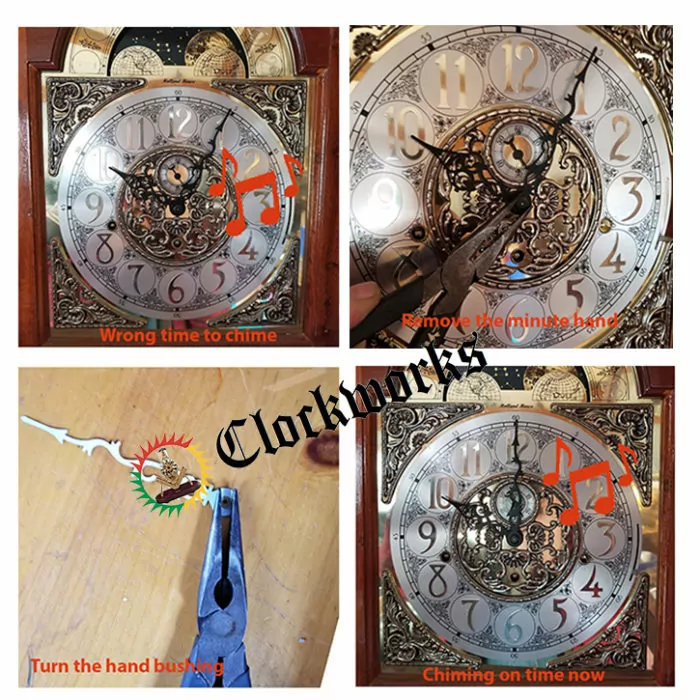
The following applies only to pendulum units
Pendulum Assembly
Clock pendulum components description
Altogether, this is a description of the clock pendulum parts and components. Please use this as a glossary for parts in a clock pendulum assembly.
Knowing the correct terms for the various pendulum parts is helpful when ordering replacements. We are quite adept at deciphering descriptions of parts however, knowing the name is always something we welcome.
The clock pendulum
First, a clock pendulum includes the bottom rating nut and threads, the pendulum bob, and top hook.
Additionally, these items are removable on wood stick pendulums only. Lyre metal clock pendulums do not have the ability to come apart.
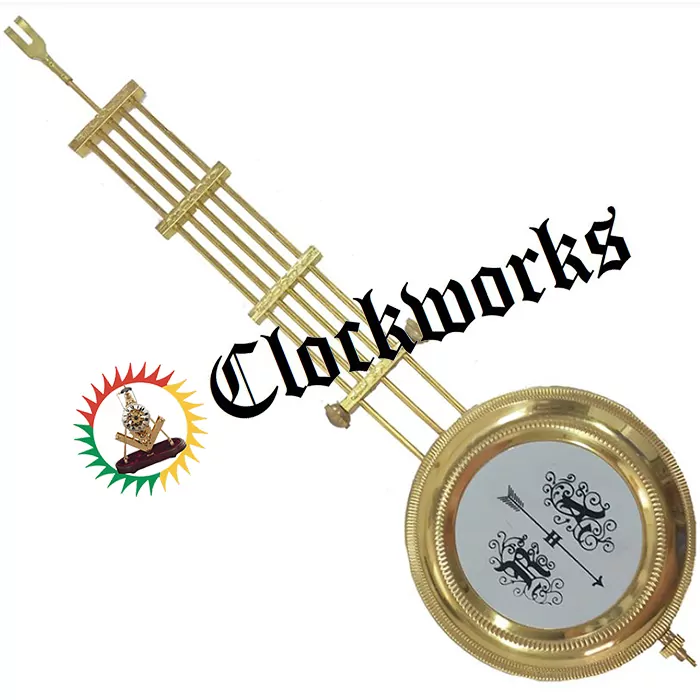
Clock pendulum leader
Second, a leader is the part that the pendulum hangs onto when it is on the clock. It then in turn hooks to the suspension spring on the very top of the pendulum assembly.
Naturally, pendulum leaders vary depending on the manufacturer of the clock movement and they can also vary in length, as well as style. Sometimes there can be more than one type of leader for the same movement.
There are also instances where we custom make leaders for customers.

Suspension spring description
The clock pendulum suspension spring is the short spring steel part on the very top of the pendulum assembly. Its purpose is to suspend the leader and pendulum in the air. Generally speaking, its steel, spring like strips, flex to let the pendulum swing back and forth with ease and momentum.

Clock Pendulum Components Complete
In summary, the clock pendulum components include the pendulum hanging on the leader and the leader hanging on the suspension spring.
Put the complete pendulum assembly on the clock and it is ready to go. The next step is to put the clock in beat and run the clock to see how the time keeping is.

Setting the beat
Mechanical clock movement beat-setting
Mechanical clock movement beat-setting means the tick and the tock sound of the clock are even. In order to run, every mechanical clock that has a pendulum needs to be put in beat. It is amazing how many clocks have not run for 10 years or more just because this is not known. Often, clocks in tag sales, auctions, and homes only need to be put in beat to run but unfortunately they were left to sit for years. The setting of the beat is easy and takes less than a couple minutes to do.
Every mechanical pendulum unit needs it
Every mechanical clock that has a pendulum needs to be in beat to function. Part of owning a clock is to know how to do mechanical clock movement beat-setting. If this is not known how to do this, then whenever moving the clock from here to there it will stop after 5-10 minutes. So learning one simple solution will keep the clock running for years.
Putting a post WW2 German clock in beat
By over swinging the pendulum, most modern German mechanical clock movements can be put back into beat. This is also known as Auto Beat and is found in most post WW2 German clock movements. It's the first thing to try when a clock will not stay running. It is ok to try this even if the clock doesn't have auto beat built in. If the clock sounds like ticktock ticktock, instead of tick-tock tick-tock, or even tocktick tocktick, then it is not in beat. The clock may stop after 5 minutes, or even an hour, if it is still not in beat. Will also hear an uneven tick and tock. A rhythmic tick-tock tick-tock can be heard when it is correctly in beat.
Skinny clock case beat setting
If it is not an auto beat or the clock case has a narrow width, mechanical clock movement beat-setting is done differently. Push the top of the pendulum left or right as it hangs in its clock case. Hold a lower portion of the pendulum with the left hand and push the top of the pendulum left or right with the right hand. There will be some resistance in the pendulum when moving it left or right. The beat of the clock will change when the pendulum goes beyond this resistance. Don’t be afraid to move this pendulum top left or right as there is nothing to break. However, twisting the pendulum can break the suspension spring. It is only meant to go back and forth.
Mechanical Clock Movement Beat-Setting Notes
The beat is the rhythmic pulsations of the escape wheel clicking over one tooth at a time. This results in the tick tock sound as each tooth "escapes" from the rocking anchor that blocks it. The anchor rocks back and forth from the pendulum motion and is only on its arbor by friction fit. In other words, it will rotate independently of the arbor it is riding on. The tick or tock sends a jumping pulse action to what is known as a crutch. Then this crutch whacks the pendulum slightly with each swing. The back and forth momentum of the pendulum, in addition to the whacking motion made by the crutch, keeps it going and going. However, this is provisional depending on whether it's even, left and right. Or in other words, the tick and tock are even. Once this happens, the mechanical clock movement beat-setting should be complete.
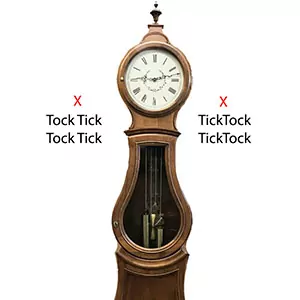
Out of Beat
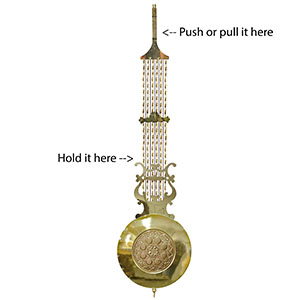
Push Pendulum
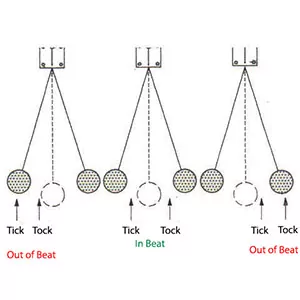
Beat Setting
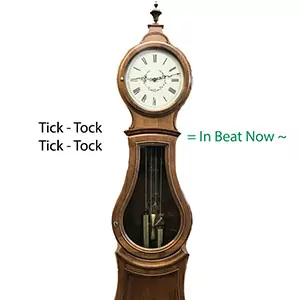
Now in Beat











